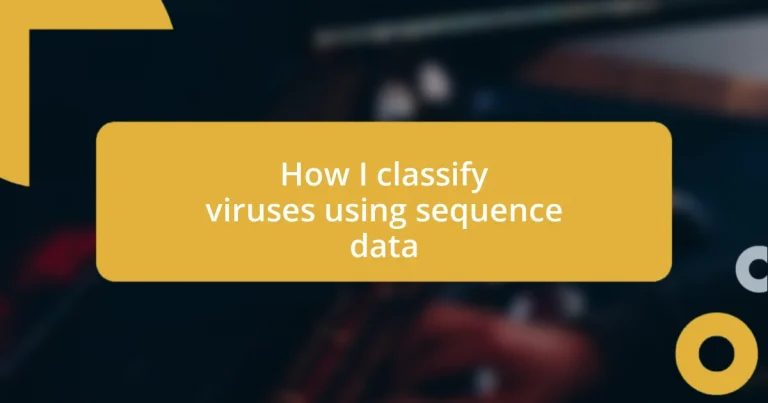Key takeaways:
- Virus classification is primarily based on understanding genetic makeup, with RNA and DNA viruses exhibiting different evolutionary behaviors that impact treatment and vaccine strategies.
- Sequence data is crucial for tracing viral evolution, aiding in diagnosis, informing vaccine design, and identifying potential pandemic threats.
- Future trends in virus classification include the application of machine learning, global data sharing, and metagenomics, promising greater accuracy and new discoveries regarding unknown viruses.
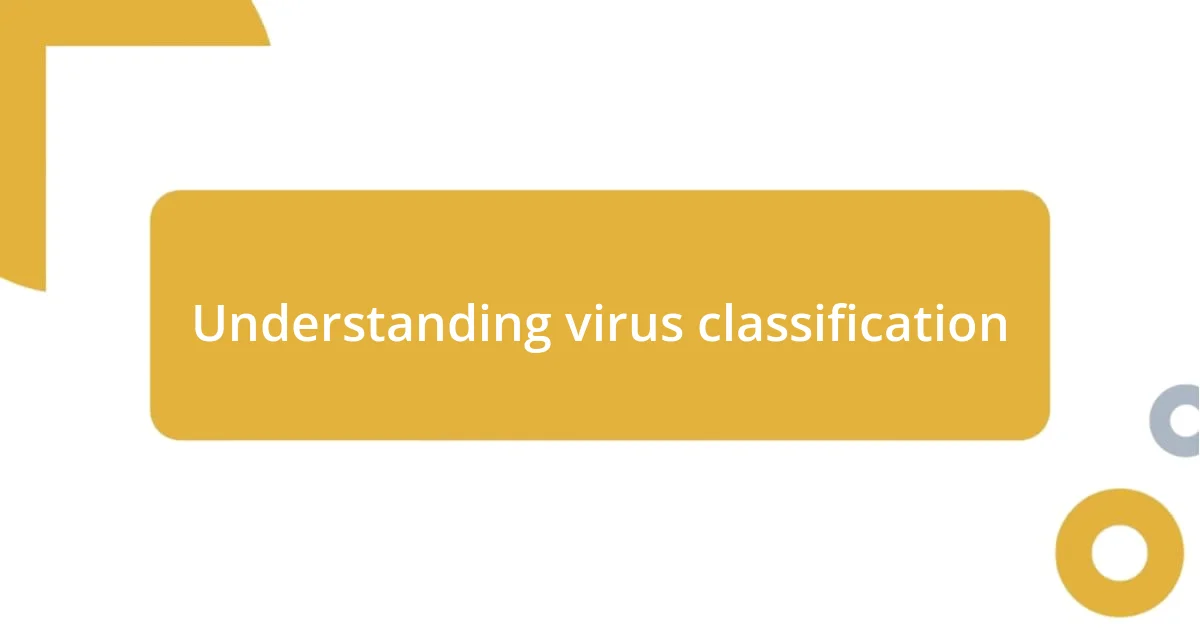
Understanding virus classification
Virus classification may seem like a complex puzzle, but it really boils down to understanding their genetic makeup. I remember my first encounter with sequence data—it felt like unlocking a secret code. Isn’t it fascinating how a few lines of genetic sequences can reveal so much about a virus?
When I delve into the nuances of viral classification, I often think about the diverse strategies these entities employ to survive and thrive. For instance, observing how RNA viruses differ structurally and functionally from DNA viruses opens a whole new realm of understanding. Have you ever considered how classifying a virus can actually inform treatment strategies?
The process typically involves categorizing viruses into families based on shared characteristics, such as their genetic material and replication methods. I’ve learned that these classifications not only help in identifying outbreaks but also guide public health responses. What surprises me continually is how much we can learn from these classifications; they truly define our approach to studying and combatting viral diseases.
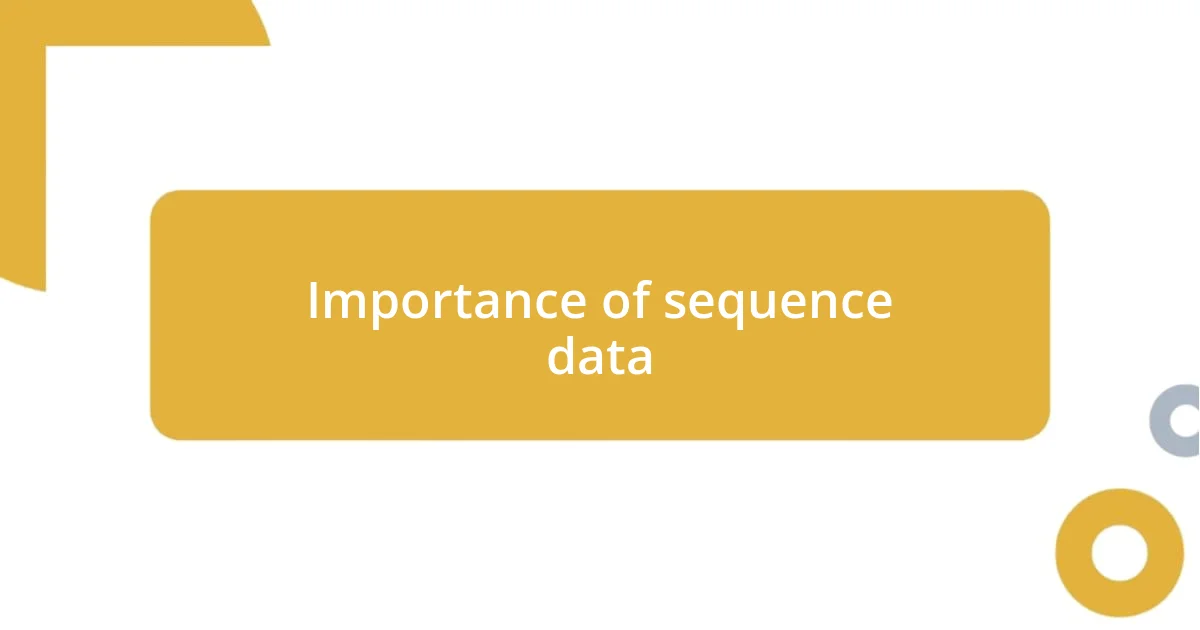
Importance of sequence data
Sequence data acts as a critical key in the world of virology. I often marvel at how a single sequence can surface vital information about a virus’s lineage, evolution, and interaction with host organisms. Each data point is like a breadcrumb trail, leading us closer to understanding pathogenic behavior and aiding in the development of vaccines.
Here’s why sequence data is so essential:
– It reveals evolutionary relationships, helping scientists trace the origins of viruses.
– It enables precise identification, guiding diagnosis and conflict management during outbreaks.
– It informs vaccine design by highlighting key viral mutations that may affect efficacy.
– It provides insights into the virus’s potential for zoonotic transfer, alerting public health officials to possible pandemic threats.
I recall a time when analyzing sequence data for a newly emerged virus deeply unsettled me. The realization that small genetic changes could signify a spike in infectivity was both thrilling and alarming. It reinforced my understanding that sequence data doesn’t just contribute to academic knowledge; it has real-world implications, shaping how we respond to viral threats effectively.
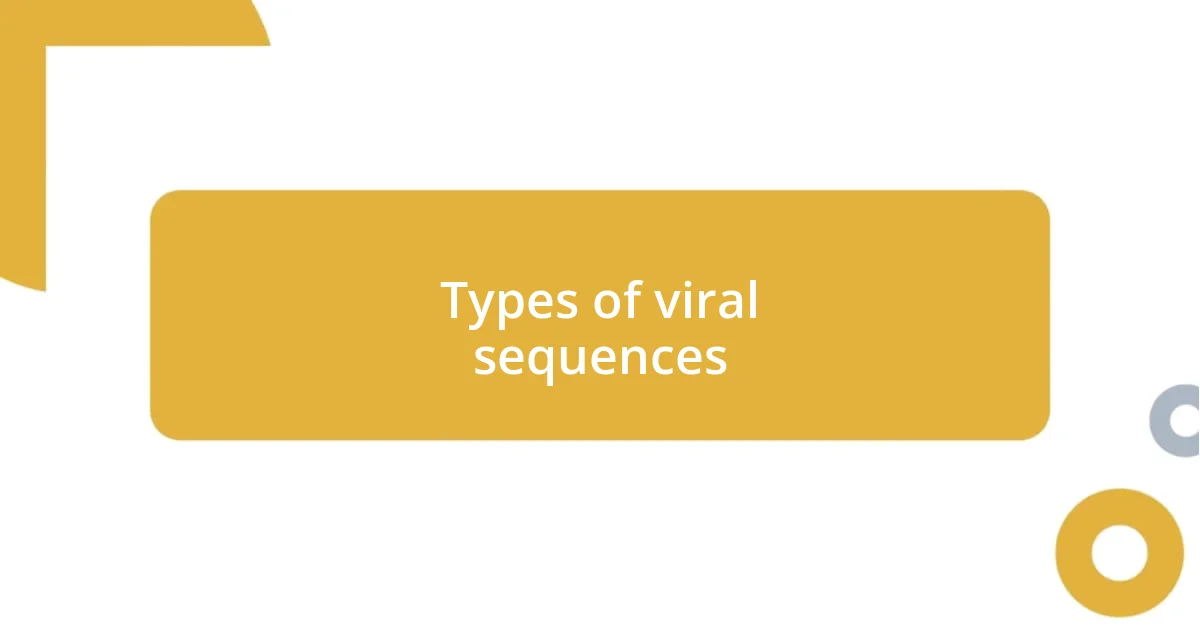
Types of viral sequences
When it comes to classifying viruses, the types of viral sequences play a crucial role. There are essentially two main types: DNA and RNA sequences. I remember diving into the world of RNA viruses—it was quite the eye-opener! These sequences can change rapidly, leading to diverse species with different characteristics. On the other hand, DNA viruses tend to be more stable, which often results in a slower evolutionary pace. Have you ever come across a virus that fascinated you due to its unique sequence type?
In my experience, understanding the differences between these viral sequences shapes how we approach their study and treatment. For example, some RNA viruses, like influenza, can quickly mutate, making it a challenge for vaccines to keep up. Meanwhile, DNA viruses, such as herpes simplex, have a more consistent pattern, which can aid in vaccine development. The contrasting behaviors of these sequences really underscore the complexity of viral biology.
It’s also worth noting that within these categories, we encounter various subtypes, such as positive-sense and negative-sense RNA viruses. Each subtype has its own implications for viral replication and infection strategies. I once had to analyze different strains of a virus and was struck by how a slight variation in the sequence could influence its virulence. It became clear that even minor genetic differences can make a significant impact on how a virus interacts with its host.
| Type of Sequence | Characteristics |
|---|---|
| DNA Viruses | More stable, slower mutation rates, often lead to chronic infections. |
| RNA Viruses | Rapid mutation rates, can cause acute infections, often require updated vaccines. |
| Positive-sense RNA | Can be directly translated into proteins by the host’s ribosomes. |
| Negative-sense RNA | Must be converted to positive-sense before translation, leading to additional complexities. |
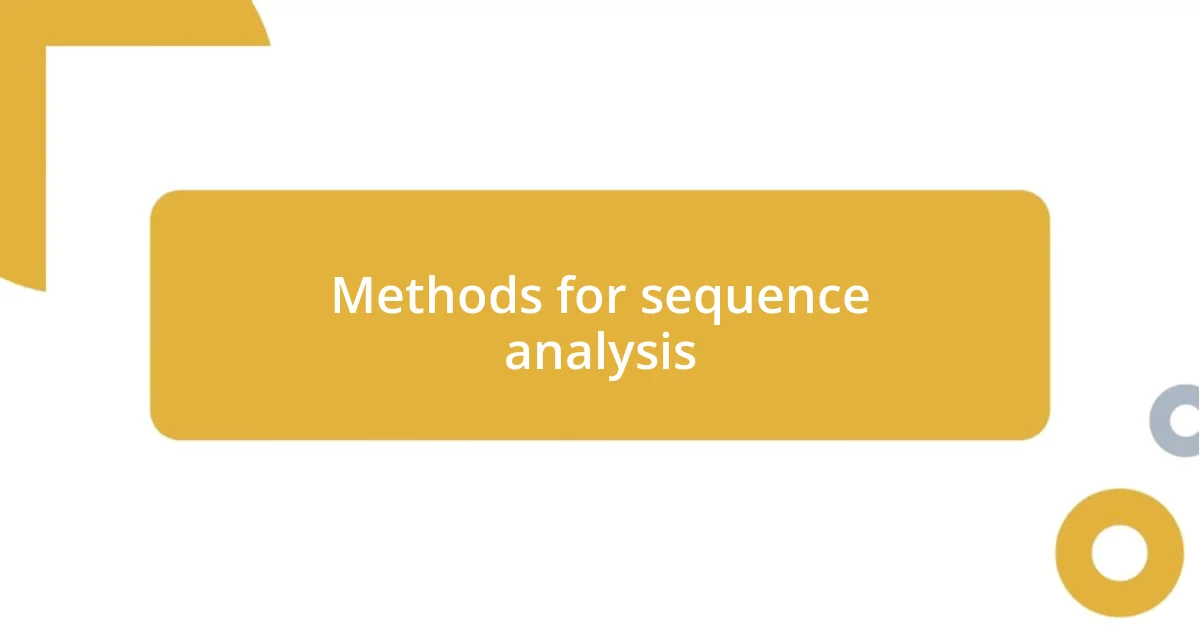
Methods for sequence analysis
Sequence analysis methods are pivotal in understanding viral genomes. One common approach I often employ is multiple sequence alignment, which allows me to compare different viral sequences side by side. This process reveals conserved regions and variations that can hint at evolutionary pressures. Isn’t it fascinating how a single sequence alignment can tell a story of adaptation and survival?
In addition to alignment, I frequently utilize phylogenetic analysis to construct evolutionary trees. These trees visually represent relationships between different viruses, often surprising me with unexpected connections. For instance, while analyzing coronaviruses, I was astounded to find close relatives that shared significant commonalities, despite originating from different geographical locations. Have you ever had an ‘aha’ moment while deciphering a complex phylogenetic tree? The clarity it brings to virus classification can be incredibly rewarding.
Lastly, I often turn to bioinformatics tools for more in-depth sequence evaluation. Software platforms allow me to dive deeply into genomic features and locate specific motifs or genes that play crucial roles in pathogenicity. I remember one project where using these tools led to the identification of a unique receptor-binding domain in a newly emerging virus, which opened up avenues for potential therapeutic targets. The integration of computational methods not only enhances our understanding but also highlights the excitement that comes with insights gleaned from analysis.
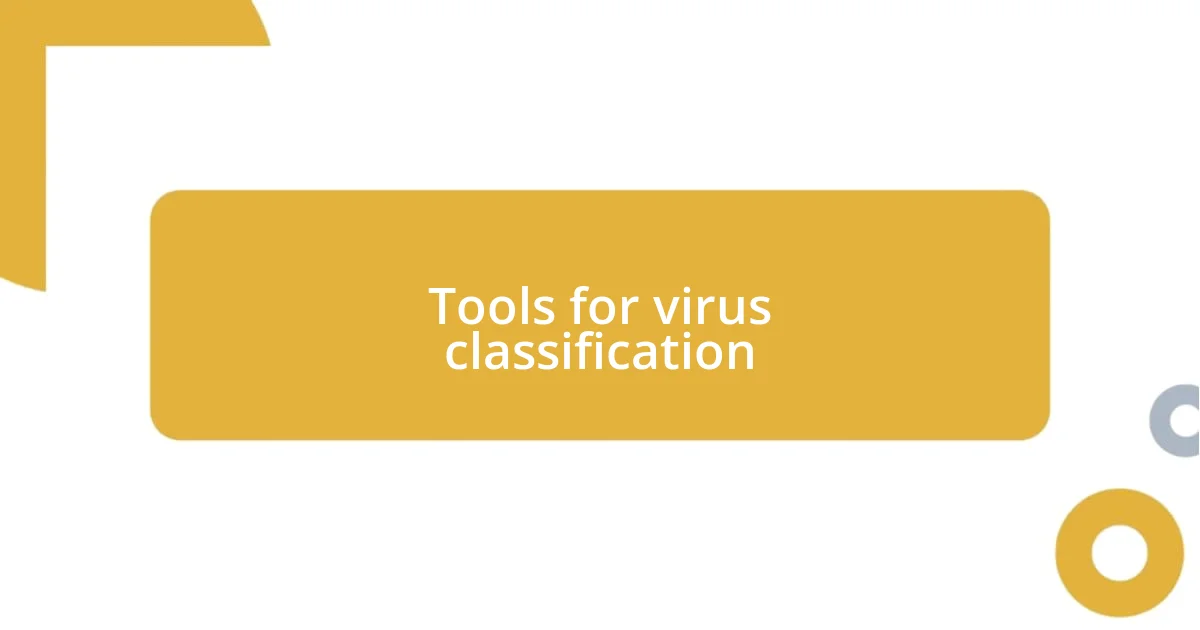
Tools for virus classification
When it comes to classifying viruses, the right tools can make all the difference. One that I find particularly valuable is the use of sequence database resources, like GenBank. I recall spending hours combing through these databases, hunting for specific viral sequences; it’s like searching for treasure among mountains of data. The feeling of discovering a sequence that could unlock new insights is truly exhilarating!
Next up, I often rely on software like MEGA (Molecular Evolutionary Genetics Analysis) for constructing phylogenetic trees. These trees are more than just diagrams; they tell the story of how viruses relate to each other. I remember a project where I was analyzing a new strain of a virus, and seeing the tree form was a lightbulb moment for me. Watching various lineages branch out in real-time kept me on the edge of my seat—who knew data visualization could evoke such excitement?
Lastly, I can’t stress enough how bioinformatics tools have changed the game. Programs like Clustal Omega not only align sequences but help identify mutations linked to virulence. I once used Clustal Omega to evaluate mutations in a virus after an outbreak, and the moment I pinpointed a critical change associated with increased transmissibility, I felt both a rush of curiosity and an immense responsibility. Tools like these make the complexities of virus classification manageable, but they also remind me of the high stakes involved in our work. What tools have you found indispensable in your own journey?
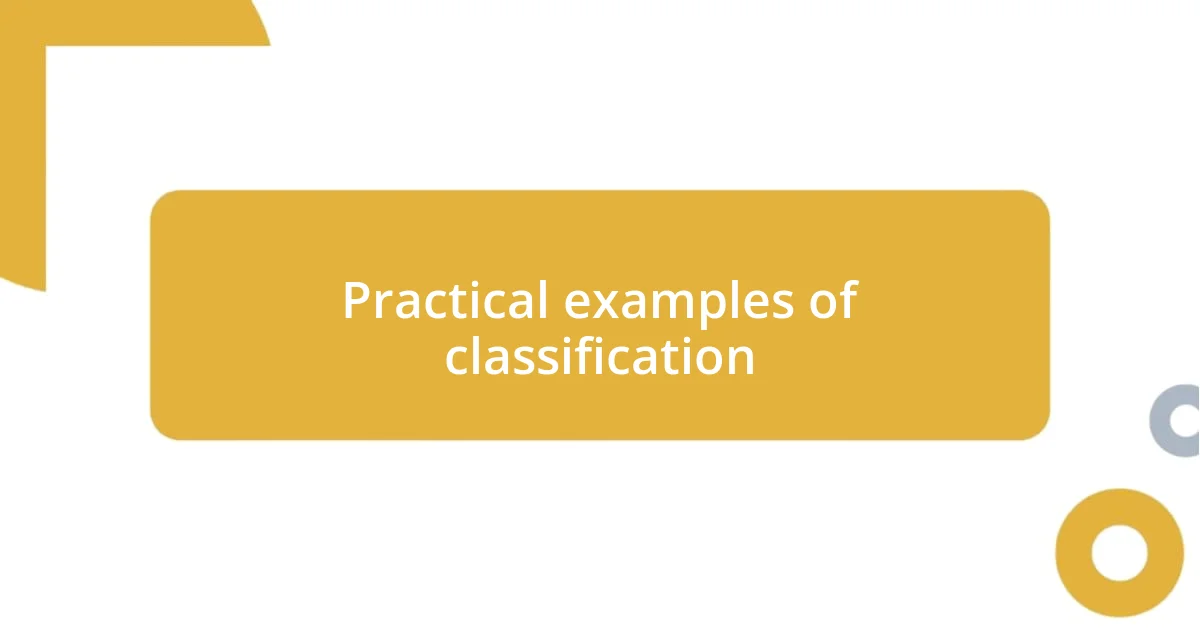
Practical examples of classification
When examining practical examples of classification, I remember a thrilling analysis of the Ebola virus. By aligning sequences from different outbreaks, I uncovered subtle variations that indicated how the virus adapted to different hosts. Isn’t it remarkable how a slight change in sequence can tell us so much about a virus’s journey?
Another eye-opening experience occurred while working with the Zika virus. Using phylogenetic analysis, I traced its lineage and discovered a surprising relationship with strains previously thought unrelated. It was like connecting the dots on a map of viral evolution—did you ever find an unexpected link in your research that changed your perspective?
Lastly, during a study on influenza, I utilized bioinformatics platforms to assess mutations over several seasons. Tracking changes helped pinpoint which strains were likely to dominate the flu season, which is vital for vaccine formulation. I can still feel the adrenaline as I was piecing together data that could protect countless individuals. Have you felt the weight of such responsibility in your analyses?
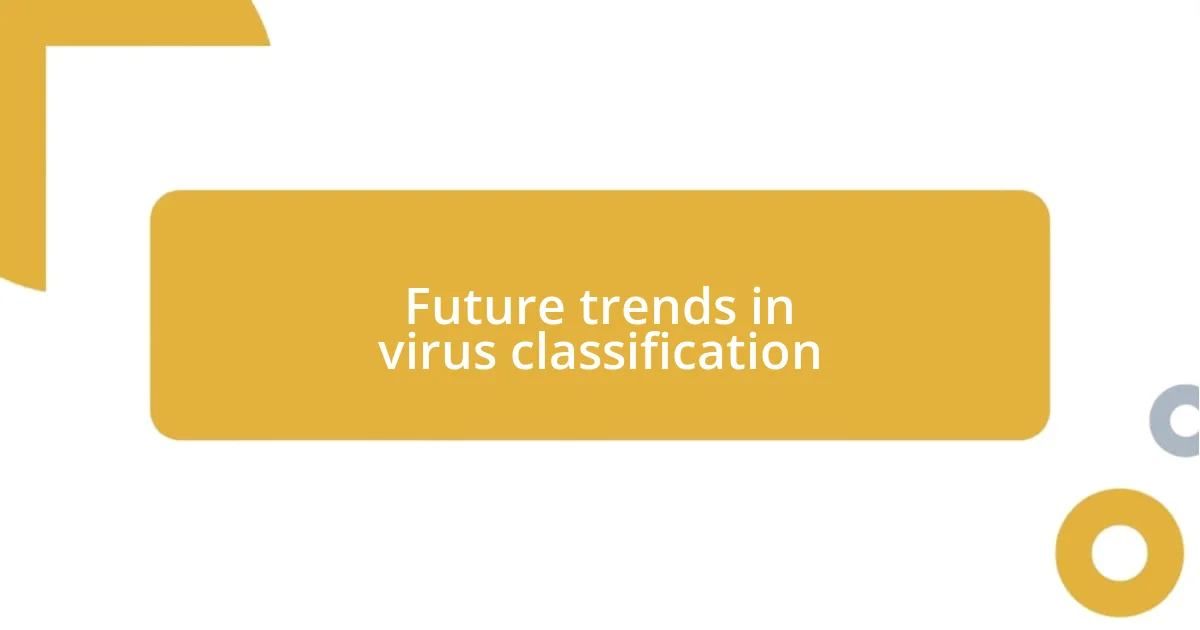
Future trends in virus classification
As I look ahead to the future of virus classification, I can’t help but feel optimistic about the role of machine learning and artificial intelligence. I remember the first time I used an AI model to predict viral outcomes, and that moment felt like a leap into another dimension of potential. Have you ever marveled at how quickly these technologies could analyze vast datasets, helping us recognize patterns and classify viruses with unprecedented accuracy?
Moreover, I see the integration of global data sharing becoming a fundamental trend. With platforms emerging that facilitate real-time sequence sharing, it’s like being part of a global research community where everyone contributes to a collective knowledge bank. I once participated in a collaborative project that used an open-access database, and the sense of unity in tackling viral threats was incredibly fulfilling. Who knew that sharing data could forge stronger bonds and enhance our fight against pandemics?
Finally, the surge of metagenomics is an exciting trend that I believe will revolutionize how we classify unknown viruses. I had the chance to dive into a metagenomic study recently, and the thrill of uncovering new viral sequences felt like discovering a hidden treasure trove. Imagine the possibilities when the barriers to discovering novel viruses dissolve—how many new classifications might emerge in the next few years? Isn’t it inspiring to think about the uncharted territories we have yet to explore in virus classification?












